
Welcome to the Tesla Memorial Society of New York Website
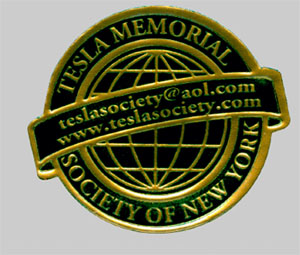
Operation Halyard - Serbs Rescued 500 American Pilots
in WWII
The following text from Harry S. Truman and the image of the Legion of Merit were taken from srpska-mreza.com:
"LEGION OF MERIT - CHIEF COMMANDER: General Dragoljub Mihailovich distinguished himself in an outstanding manner as Commander-in-Chief of the Yugoslavian Army Forces and later as Minister of War by Organizing and leading important resistance forces against the enemy which occupied Yugoslavia, from December 1941 to December 1944. Through the undaunted efforts of his troops, many United States airmen were rescued and returned safely to friendly control. General Mihailovich and his forces, although lacking adequate supplies, and fighting under extreme hardships, contributed materially to the Allied cause, and were instrumental in obtaining a final Allied victory."
- Harry S. Truman, March 29, 1948.
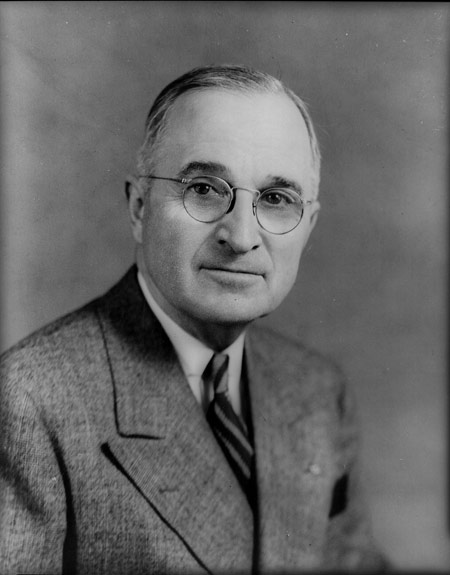
Above: President Harry Truman awarded General Dragoljub Mihailovich the Legion of Merit. Image from umbc.edu.
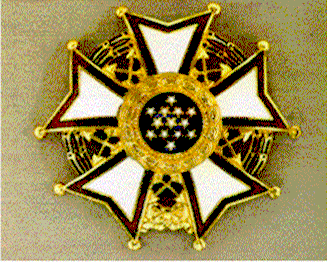
Above: The Legion of Merit awarded to Dragoljub Mihailovich by President Truman.
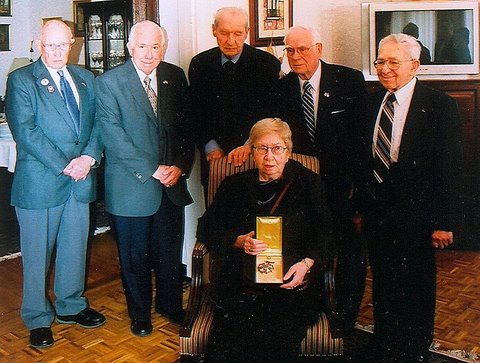
Mihailovich’s daughter, Gordana Mihailovich, accepting her father’s Legion of Merit.
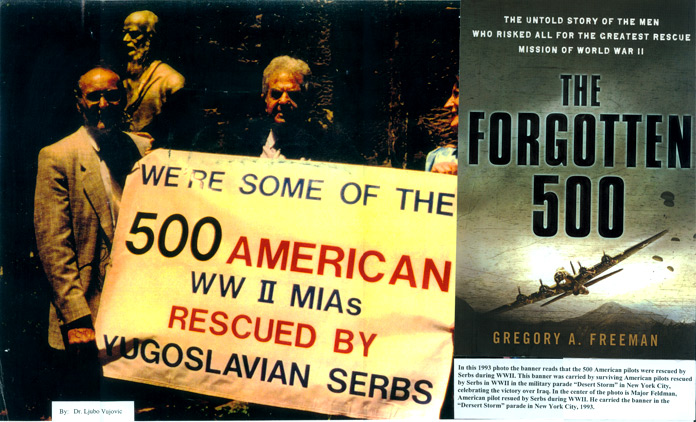
Above: In this 1991 photo the banner reads that the 500 American pilots were rescued by Serbs during WWII. This banner was carried by surviving American pilots rescued by Serbs in WWII in the military parade "Desert Storm" in New York City, celebrating the victory over Iraq. In the center of the photo is Major Feldman, American pilot rescued by Serbs during WWII. He carried the banner in the "Desert Storm" parade in New York City, 1991.
Photo by Dr. Ljubo Vujovic, 1991.
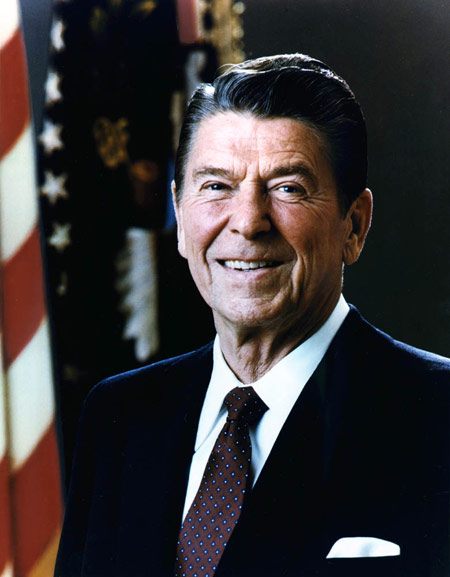
Above: President Ronald Reagan wrote to Mr. Michael Radenkovich about General Draza Mihailovich. Image from huffingtonpost.com.
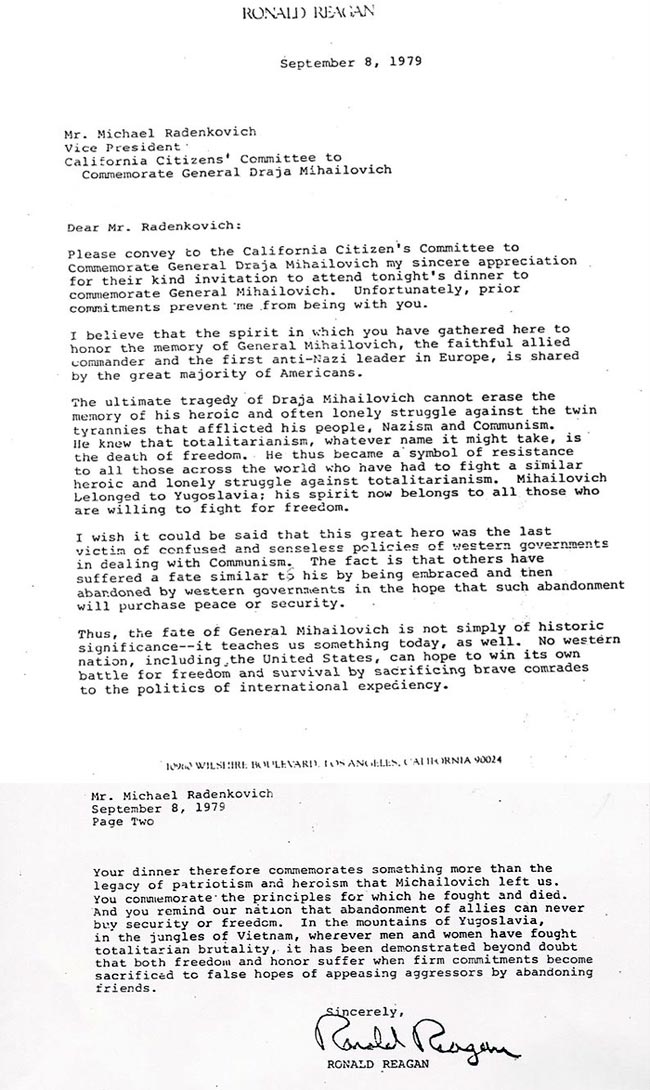
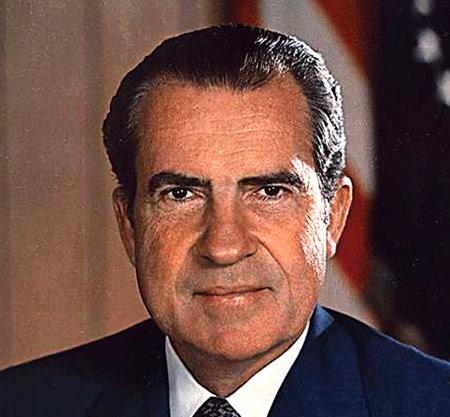
Above: President Richard Nixon paid tribute to General Draza Mihailovich. Image from visitingdc.com.

Above: President Richard Nixon pays tribute to General Draza Mihailovich on April 21, 1966.
The following New Year’s greeting was sent by General Dwight Eisenhower, who was to become the Supreme Allied Commander in Europe, to General Draza Mihailovich, on January 1, 1943 (taken from draza-mihailovich.blogspot.com):
“The American forces in Europe and Africa send greetings to their comrades in arms, the resourceful and gallant Yugoslav military units under your splendid leadership. These brave men banded together on their native soil to drive the invader from their country are serving with full devotion the cause of the United Nations. May the New Year bring them full success.” - General Dwight Eisenhower, January 1, 1943

Above: General Dwight Eisenhower.
Photo from draza-mihailovich.blogspot.com.
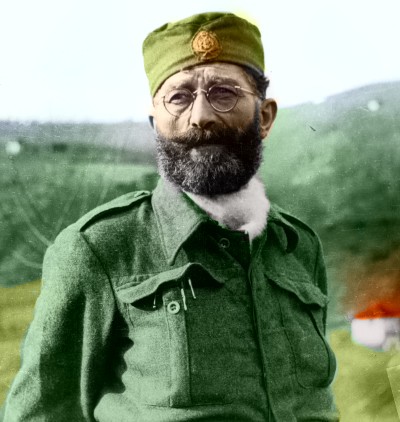
Above: General Draza Mihailovich.
Photo from draza-mihailovich.blogspot.com.
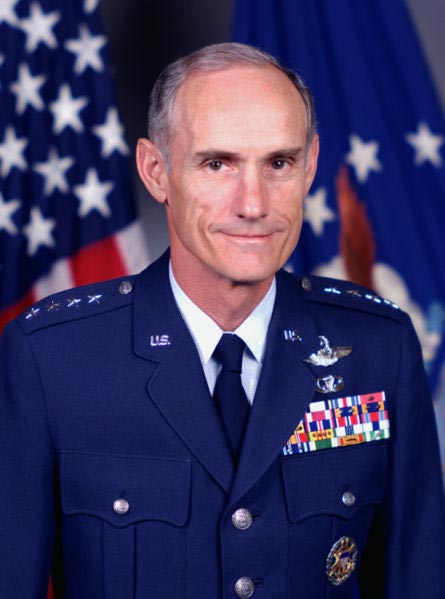
Above: General Merrill McPeak, USAF, Chief of Staff
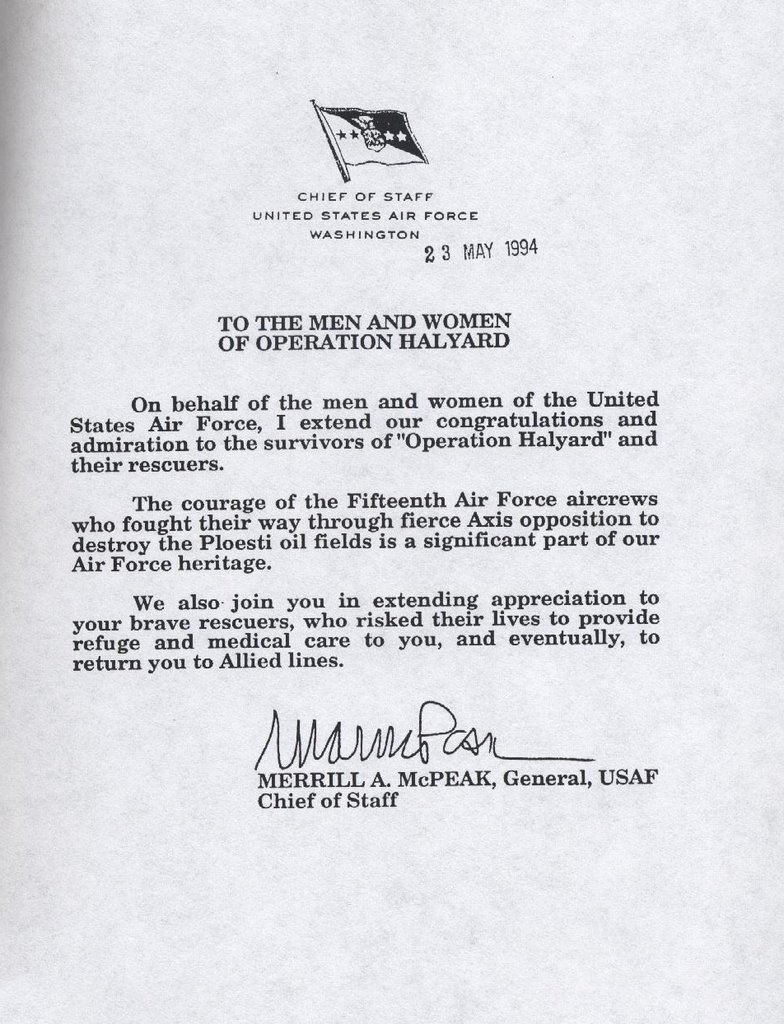
Above: USAF Chief of Staff General Merrill McPeak salutes the survivors of "Operation Halyard" and their Rescuers on the 50th Anniversary. (image from draza-mihailovich.blogspot.com)
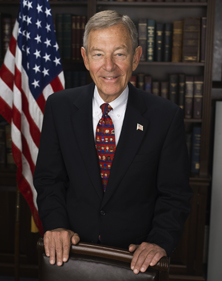
Above: Senator George V. Voinovich

Above: Ohio Governor George Voinovich honors "Halyard Mission" May 1994.
(Image from draza-mihailovich.blogspot.com)
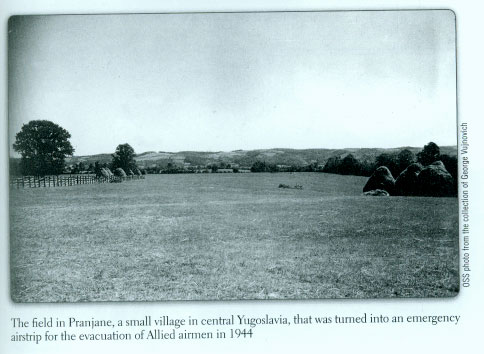
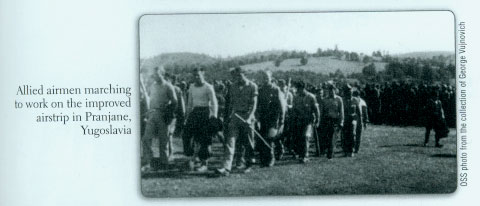
The following images and text was taken from belgrade.usembassy.gov:
Embassy of the United States of America
Belgrade
WWII Veterans Delegation Visit Serbia
A group of American World War II veterans visited Serbia September 9-16 at the invitation of Serbia and Montenegro's Foreign Minister Vuk Draskovic to commemorate the sixtieth anniversary of Operation Halyard, when troops led by General Dragoljub Mihailovic saved the lives of several hundred U.S. airmen who were shot down over Serbia by Nazi forces.
During the Summer of 1944 approximately 1, 000 U.S. airmen bailed out over German-occupied Yugoslavia, a significant number of them landing in Serbia. In a series of daylight and night airlifts, a team made up of troops of General Mihailovic's Royal Yugoslav Army in the Homeland and the Office of Strategic Services (O.S.S.) evacuated over 250 U.S. airmen from the village of Pranjani.
The rescue of the U.S. airmen involved small unit actions against German troops and put at risk entire Serb villages that sheltered the U.S. personnel. U.S. airmen bear testimony to the significant sacrifices of local Serb villagers who fed, cared for and protected them, in some cases up to six months.
The four American veterans, Clare Musgrove, Art Jiblian, George Vujnovich and Robert Wilson visited Pranjani again on September 12, 2004 for the unveiling of a commemorative plaque at the Pranjani airfield.
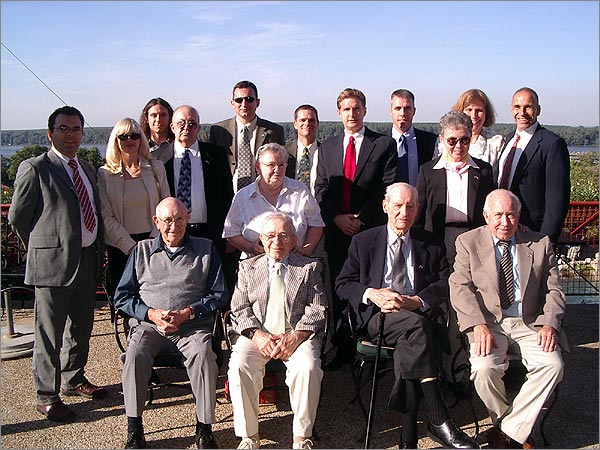
From Left to Right: Front Row Seated, all four veterans: Clare Musgrove, Art Jiblian, George Vujnovich, Robert Wilson; Second Row: Mrs. Beverly Jo Jiblian, Mrs. Sharon Wilson; Third Row: Bojan Dimitrijevic from the MFA, Mrs. Karen Milutinovic, George Knezevic, MAJ Aleks Milutinovic, MAJ Tom Newcomb, Charge Roderick Moore, MAJ Sam Shult,
Mrs. Chris Drake, COL Gordon Drake; Last Row: Gordon Musgrove
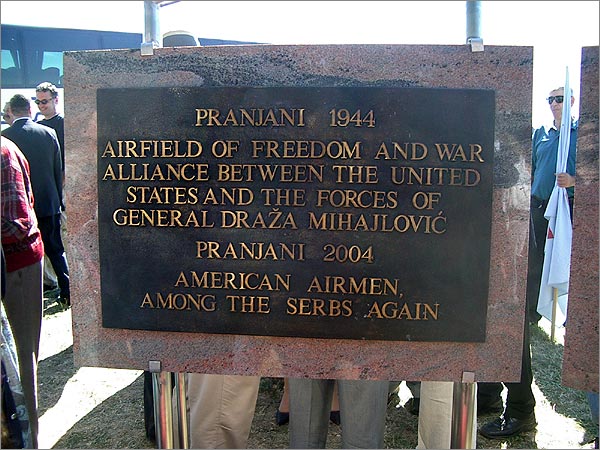
Plaque unveiled at former Pranjani airstrip
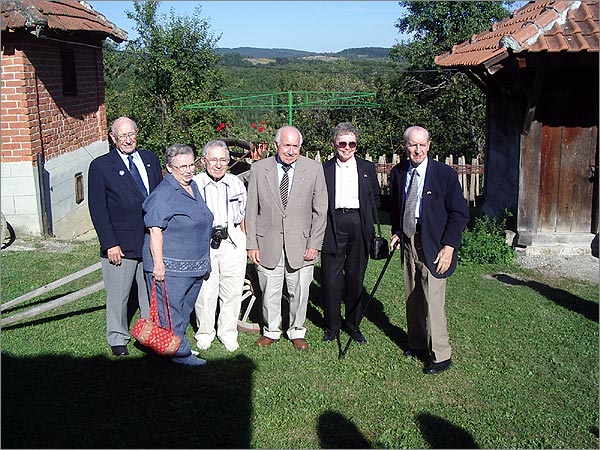
From Left to Right: Clare Musgrove, Mrs. Beverly Jo Jiblian, Art Jiblian, Robert Wilson, Mrs. Sharon Wilson,
George Vujnovich
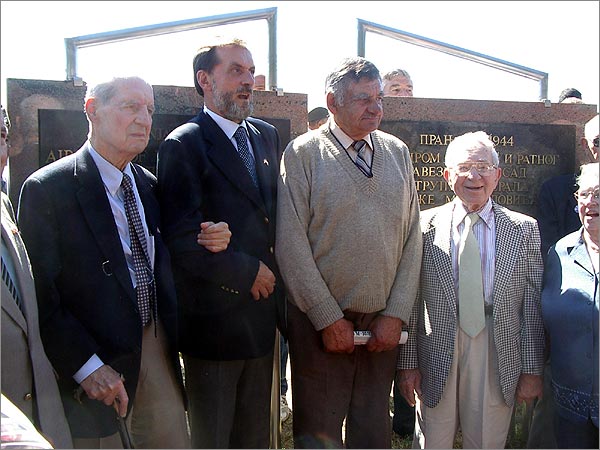
FM Vuk Draskovic and veterans at former Pranjani airstrip
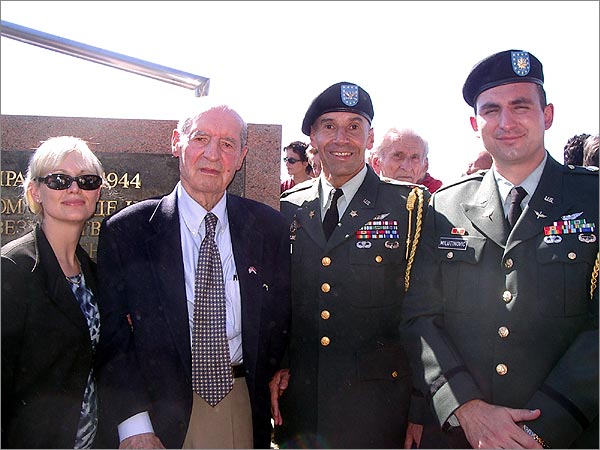
From Left to Right: Mrs. Karen Milutinovic, George Vujnovich, COL Gordon Drake, MAJ Aleks Milutinovic
The following text and image were taken from www.babamim.com:
Serbian History 101 with Baba Mim....
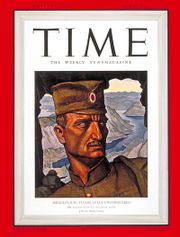
TIME Magazine had Chica Draza Mihailovich as their "Man of the Year" and people around the world hailed the leader and his heroic resistance fighters in 1941, the FIRST to stand up to Hitler's Germany.
My copy of the LIBERTY magazine from April 25, 1942. "The Story of Draja (Draza) Mihailovitch
(Mihailovic/Mihailovich) -Fighter for Freedom."
The caption reads: "The headache: General Draja Mihailovitch, Yugoslav War Minister and Chetnik commander in chief." (p.18-LIBERTY magazine)
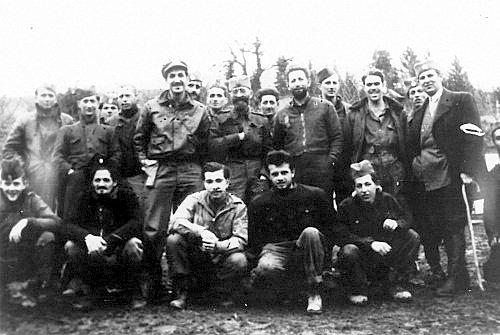
A photo of some of the airmen with Nick Lalich with hat. Radioman Arthur ("Jibby") Jibilian is kneeling in light-colored jacket in front. To Lalich's right in a "sjakaca" hat is Bobby Marjanovich of Aliquippa, PA, who was studying for the priesthood in Belgrade, and was rescued by the Maksimovich Brothers singers when the unexpected bombing of the city by the Germans began.
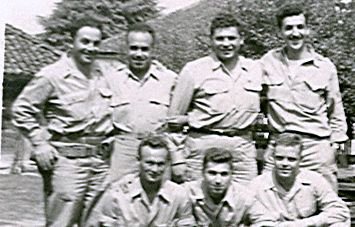
The ACRU & Medical Team. Note George Musulin (3rd from left), hugging Nick Lalich in the back row. The "Milosh Obilich-Kosovo 1389-1937" button from Wilmerding belonged to him! (See Kosovo page) Don't ever let ANYONE ever steal your history! Pittsburgh's Musulin was the person initially dropped behind the lines in charge of the Mission, replaced by Lalich. Jibby in the front middle.
The following is text taken from Wikipedia:
Operation Halyard
Operation Halyard was the largest Allied airlift operation behind enemy lines, of over 500 Allied airmen downed over Nazi occupied Serbia by Serbian Chetnik guerrillas, led by General Dragoljub Mihailović, with the assistance of American Office of Strategic Services (OSS) liaison officers. Most of the airmen had been shot down during numerous bombing runs, most of which were on their way from Italy to bomb German occupied oil fields in Romania. They were not captured, but instead practiced escape and evade until coming into contact with the Chetniks.
This operation took place between August and December 1944 from a crudely constructed airfield created by Serbian peasants in Pranjane, Serbia. It is little known today, and largely unknown to most Americans. It is the subject of the 2007 book The Forgotten 500: The Untold Story of the Men Who Risked All For the Greatest Rescue Mission of World War II, by author Gregory A. Freeman. In his book, he describes it as one of the greatest rescue stories ever told. It tells the story of how the airmen were downed in a country they knew nothing about, and how the Serbian villagers were willing to sacrifice their own lives to save the lives of the air crews.
The OSS planned an elaborate rescue involving C-47 cargo planes landing in enemy territory. It was an extremely risky project, involving the planes not only entering enemy territory without being shot down themselves, but also landing, picking up the downed airmen, then taking off and flying out of that same territory, again without being shot down themselves. The rescue was a complete success, but received little to no publicity. Part of this was due to the timing, and the world being focused on the D-Day operations in France.
Because of this operation, and due to the efforts of Major Richard Felman, U.S. President Harry S. Truman posthumously awarded General Mihailović the Legion of Merit award for his contribution to the Allied victory during World War II.[1] The award was presented to Mihailović's daughter Gordana by the U.S. State Department on May 9, 2005.
For the first time in history, this high award and the story of the rescue was classified secret by the U.S. State Department so as not to offend the then Communist government of Yugoslavia. Such a display of appreciation for the Chetniks would not have been welcome as the Allies switched sides to Josip Broz Tito's Partisans during the war.
On September 12, 2004, four American veterans, Clare Musgrove, Art Jiblian, George Vujnovich and Robert Wilson visited Pranjani again for the unveiling of a commemorative plaque at the Pranjani airfield. [2]
The following is text from historynet.com:
Rescue Behind Enemy Lines
Muted cheers erupted when the crowd caught the sound of the approaching C-47s. Rajacich rushed out onto the field with an Aldis lamp to give the identification code, squeezing the trigger three times with the predetermined signal: Red, Red, Red. The lead C-47 responded with the same signal. Rajacich gave the go-ahead signal for landing, to which the plane responded with the prearranged code word, X-ray.
“We’re on boys! This is it!” Musulin shouted to his men, who again burst into cheers. On Musulin’s orders, his men torched hay bales and set off flares to mark the edges of the field.
Now came the trickiest, most terrifying part of the operation for the pilots of the Fifteenth Air Force’s 60th Troop Carrier Group—landing in near-darkness on an improvised runway deep in enemy territory. The first of four C-47s overshot the runway and was forced to go around again. The other planes touched down successfully, followed by the first aircraft on its second try. The only mishap was one aircraft’s minor run-in with a haystack, which dented the C-47’s wingtip.
Within a half-hour of the lead aircraft’s touchdown, the first evacuees had said their emotional farewells to the Serb families who had sheltered them, and the fully loaded planes were ready to go. Seconds before takeoff, the side doors of all four planes swung open to reveal the rescued airmen unlacing their boots and holding them up for the villagers to see. One after another, the airmen tossed their boots out to the Serb villagers as a final expression of gratitude to their caretakers, many of whom had nothing to wear on their feet but traditional Serb felt slippers.
All four C-47s took off successfully, though just barely. Two more flights of C-47s duly arrived at the makeshift airfield the next morning, this time with a strong escort of P-51 and P-38 fighters. The fighters peeled off, shooting up neighboring German garrisons as a diversion, and the C-47s were able to land much more safely than they had the previous night.
In only the first two days, Operation Halyard successfully retrieved 241 American airmen—but the OSS team was less successful when it came to obeying the government edict that the agents not furnish any supplies or give any aid to Mihailovich’s men. George Musulin, who approved the evacuation of two seriously wounded Chetniks along with the Allied airmen, was ordered home in August 1944 for aiding Mihailovich’s forces; he was replaced as mission commander by Lt. Nick Lalich.
But as Halyard continued, events in the rest of Yugoslavia conspired to interrupt it. Tito, now firmly in control of all Yugoslav provinces except Serbia and parts of Bosnia, launched a final drive in September 1944 to solidify his grasp on power, surrounding Pranjani with his Partisan army and crushing Mihailovich’s forces. The Chetniks were forced to evacuate Pranjani on September 10, and from that point forward, Operation Halyard resembled a traveling road show throughout Serbia and Bosnia. Evacuations over the next three months were improvised affairs, using whatever broad, flat spaces were available—mostly farm fields. And even as the Chetniks moved into Bosnia in Halyard’s final phase, they collected airmen to be brought for evacuation: not just Americans, but British, French, Italian, and Russian aviators as well.
By December 1944, the OSS decided that Operation Halyard had run its course. The end of the Ploesti campaign meant there were no more planes flying over the region, and no newly downed airmen requiring rescue. By the time of its termination, Vujnovich’s team had airlifted 512 downed Allied airmen without the loss of a single airman or plane—a truly impressive accomplishment. The last evacuation flight, which also carried the operation’s OSS team, left Boljanic, Bosnia, on December 27, 1944. In a final and surprising gesture of generosity, Nick Lalich’s OSS superiors radioed Draza Mihailovich an offer to evacuate him on the last flight out. Though he was in desperate straits due to Partisan resistance and the Allied ban on material aid and support, Mihailovich declined, preferring to share the fate of his people instead.